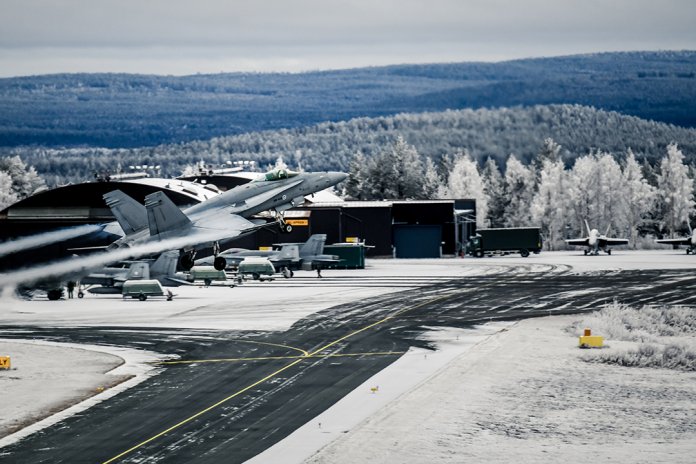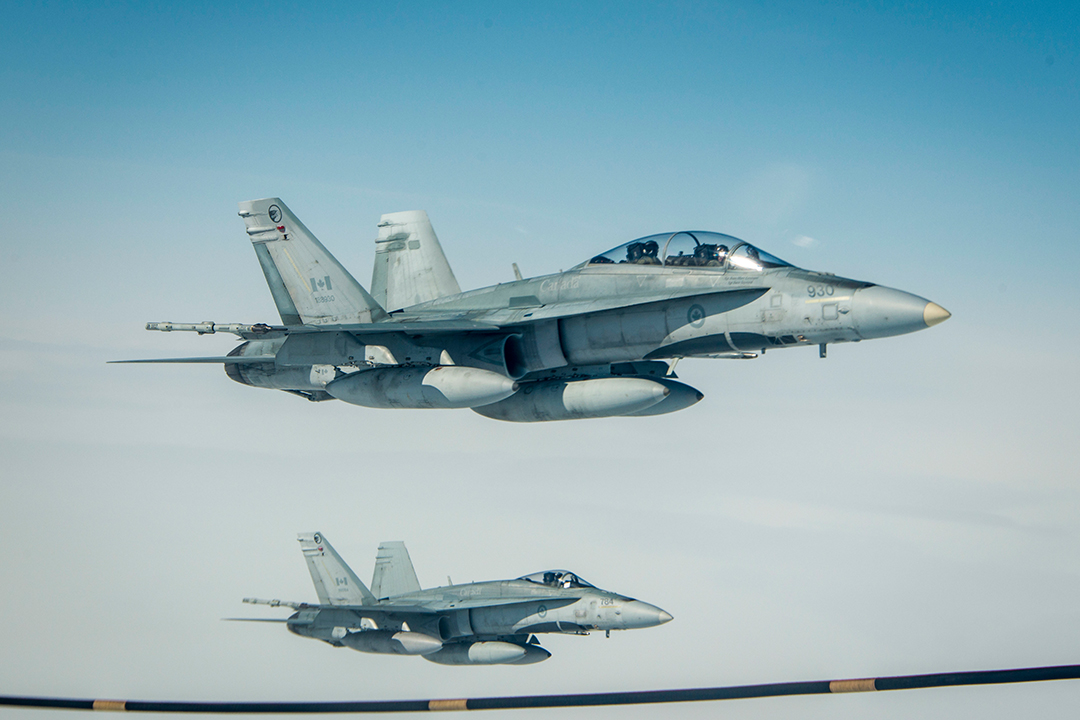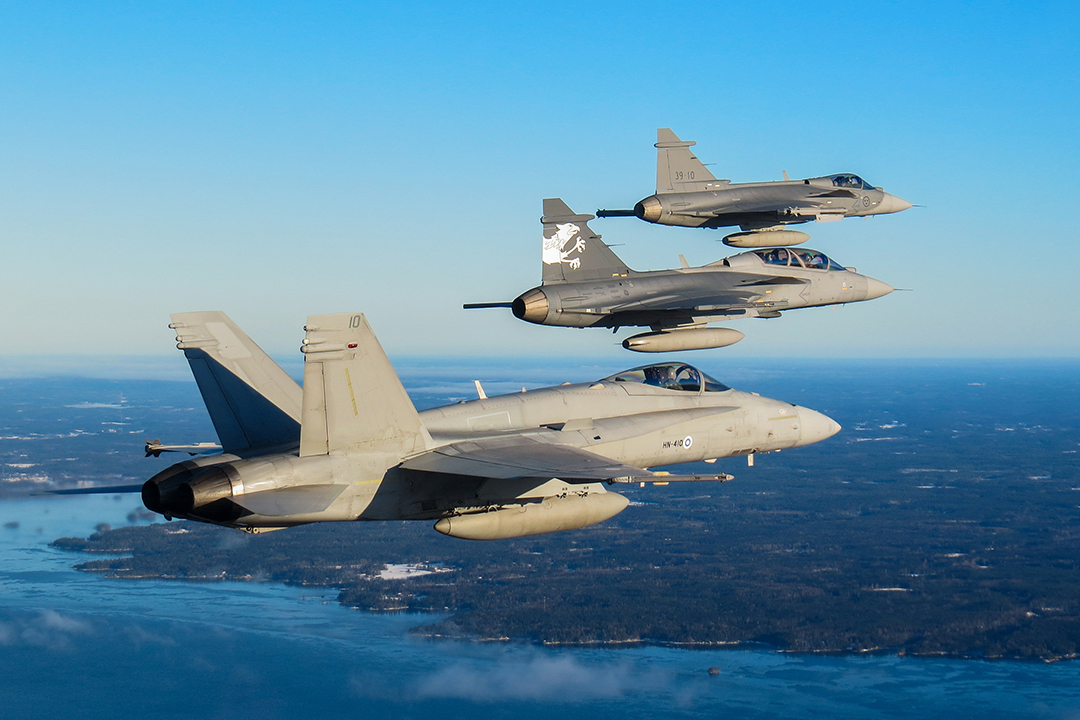
Published in the February/March 2021 Issue – Decisions by Canada, Finland and Switzerland over which new fighter they will select to replace their existing F/A-18s are eagerly anticipated in 2021.
The current worldwide COVID-19 pandemic will inevitably impact national defence budgets but some of the largest procurement programmes have so far been ring-fenced. These include billion dollar contracts for new multirole fighter aircraft for Canada, Finland and Switzerland to replace their respective McDonnell Douglas (now Boeing) F/A-18 Hornet fleets.
Canadian Confusion
In July 2010, Canada’s Conservative government announced that it intended to procure 65 Lockheed Martin F-35A Lightning II Joint Strike Fighter (JSF) aircraft to replace the Royal Canadian Air Force’s (RCAF) existing 80 CF-18A/B Hornets for $7 billion with deliveries planned for 2020. With this announcement, Canada became an F-35 component supplier but after years of technical problems, and missed deadlines, and a new government, Canada became the first nation to cancel their order and purchase of 18 F/A-18E Super Hornets as an interim solution instead.
The Canadian government then cancelled the $5.23 billion Super Hornet purchase in 2017, in apparent retaliation for Boeing’s trade-violation complaint that led the US Commerce Department to investigate sales of Bombardier C-Series passenger jets to Delta Air Lines.
In December 2017 Canada launched a new competition for 88 new fighter aircraft worth an estimated $15 billion under its Future Fighter Capability Project (FFCP) programme. In the meantime, the government announced that it was spending an estimated $3 billion to extend the lives of the CF-188 fleet and buy 18 former Royal Australian Air Force (RAAF) F/A-18A/B aircraft that will fly with the RCAF until the last of the new fighters arrives in 2032.

Initially five government-backed teams announced their intention to enter the FFCP programme but in November 2018 Dassault Aviation informed the Canadian government that it was withdrawing the Rafale from the FFCP competition. Having reviewed the draft Request for Proposal (RfP) and the Canadian requirements for intelligence data sharing and interoperability, particularly with US forces, Dassault stated that they would be difficult to meet. In September 2019 the UK Ministry of Defence (MoD) and Airbus notified Canada of their decision for the Eurofighter Typhoon not to participate in the competition to replace the CF-18. The announcement cited requirements to integrate the aircraft into the North American Aerospace Defense Command (NORAD) and technology transfers as barriers to a successful bid.
The three remaining teams vying to win the FFCP contract comprise Saab, partnered with Diehl Defence, MBDA UK and Rafael, offering the JAS 39E/F Gripen, Lockheed Martin and Pratt & Whitney proposing the F-35A, and Boeing, with Peraton Canada, CAE, L3 Technologies, GE Canada and Raytheon Canada offering the Block III F/A-18E/F Super Hornet. All the bidders are supported by their respective governments.
The Lockheed Martin team have highlighted the fact that Canadian federal government was the first nation to sign on to the US JSF partnership and to date more than 110 Canadian companies have contributed to the development and the production of the F-35 resulting in some $2 billion in contracts. However, under the current rules of the JSF partnership agreement with Canada, Lockheed Martin cannot offer traditional industrial and technological benefits to Canadian industry as an incentive to select the F-35A.
Due to the COVID-19 pandemic, the deadline for bids was extended to 31 July 2020. In September 2020 Saab and the Consortium for Research and Innovation in Aerospace in Quebec (CRIAQ) signed a Memorandum of Understanding (MoU). This collaboration has been formed to support Saab’s future Industrial and Technological Benefit (ITB) commitments, if the Gripen fighter is selected for Canada’s Future Fighter Capability Project (FFCP).
An initial evaluation is to be completed by spring 2021 with a contract award expected sometime in 2022 to allow deliveries to begin in 2025.
Finland’s Decision
In 2021, the Finnish Defence Force will select a new fighter to replace its fleet of F/A-18C/D Hornet fleet aircraft as part of its HX programme launched in October 2015. Boeing’s F/A-18E/F Super Hornet and EA-18G Growler, Dassault’s Rafale, Eurofighter’s Typhoon, Lockheed Martin’s F-35A Lightning II and Saab’s Gripen JAS 39E/F Gripen are competing for the 64 aircraft contract. On 31 January 2019, Saab submitted a revised offer in response to the revised Request for Quotation (RfQ) for the Finnish HX programme which has a cost limit of $12 billion. In addition to 52 Gripen E and 12 Gripen F fighter aircraft, Saab offered to include two GlobalEye AEW&C aircraft.
The HX Fighter Programme is critical for Finland’s defence capability and determines the Air Force’s entire combat capability into the 2060s. Finland needs fighters to safeguard the integrity of its airspace and provide support for the the Army and the Navy. New fighters may also be used for engagement of stand-off targets and complement reconnaissance, surveillance and C2 in the Defence Forces.
The HX Challenge was carried out at Pirkkala Air Base in central Finland in January 2020 with tests performed under Finnish winter conditions, in order to verify data previously supplied by the fighter manufacturers. During the two weeks of testing, the fighter candidates also participated in simulated exercises to display their capability in operating in battle scenarios as part of Finland’s defence systems.

A total of 40 mission were flown over two weeks to test aircraft performance, sensors at range, as well as their resolution and ability to maintain tracking while targets used manoeuvring or employed countermeasures. They also determined the workload and speed associated with preparing the weapon system to attack a ground target, and in the case of a long-range attack with standoff weapons, if the aircraft can be provided with more specific target data by a datalink. The flights were also used to measure the each of the fighter’s capability to identify and locate electronic signals and produce situational awareness of the target area.
Two Eurofighter aircraft, a two-seat Typhoon TMk3 and a single-seat FGR Mk4 from the Royal Air Force’s (RAF) No. 41 Test and Evaluation Squadron, were the first to take part in the trials. They were followed by a French Air Force two-seat Rafale B F3R from EC 2/4 La Fayette and a Joint-DGA and Dassault Rafale B testbed. From Saab the two-seat Gripen NF demonstrator and a Gripen E trials aircraft equipped with Iris-T, Meteor air-to-air missiles, and the Electronic Attack Jammer Pod flew the trials, while a GlobalEye took part in a separate trials in the south of Finland. Lockheed Martin’s two USAF F-35As from the 56th Fighter Wing at Luke AFB in Arizona and two Super Hornets, a US Navy F/A-18E, an F/A-18F and an EA-18G Growler completed the contending trials aircraft.

However, Finnish Ministry of Defence Programme director Lauri Puranen noted one of the F-35As could not complete the missions due to a technical problem although the other teams complete them all.
In September 2020 BAE Systems and Leonardo were awarded a contract to develop the Active Electronically Scanned Array (AESA), the European Common Radar System Mark 2 (ECRS Mk2) radar and MBDA’s SPEAR medium-to-long-range strike weapon for RAF Typhoons, both of which will be included in its HX offer.
In October the US State Department approved the sale of the F-35A JSF and F/A-18EF Super Hornet to Finland, paving the way for the nation to purchase American jets should either Boeing or Lockheed Martin win the competition. The approved sales of both types would include air-to-air missiles and air-to-ground precision guided munitions and related equipment.
Lockheed Martin offer drew attention to the fact that neighbouring Norway’s F-35As have been successfully operating in the country’s harsh North Atlantic and Arctic climate. Norway declared Initial Operating Capability (IOC) for its F-35A fleet in October 2019 after which the aircraft launched their first NATO peacetime mission safeguarding Icelandic airspace out of the Keflavik Air Base.
Boeing had stressed the fact that there would be 60 percent commonality of production and ground support between the Hornet and the Super Hornet with co-production offered to Patria which assembled the F/A-18C aircraft in Finland. The US manufacturer also drew attention to the potential reduction conversion training for air and ground crews between new and old F/A-18s.
The competing manufacturers responded to a revised RfQ with a Best And Final Offer (BAFO) by the end of January 2021. A decision is planned for later this year with the winning type set to achieve IOC in 2027, and FOC in 2030.

Swiss Temptations
With the backing of a national referendum, held in September 2019 Switzerland is proceeding with the procurement of 40 new fighter aircraft to replace its fleets of F/A-18C/D Hornet and Northrop F-5E aircraft between 2025 and 2030 as part of its Air2030 programme worth $7.2 billion.
The approval followed in-country evaluation of the Dassault Rafale, Eurofighter Typhoon, Boeing F-18E/F Super Hornet, and Lockheed Martin F-35A Lighting II combat aircraft at Payerne Air Base at the end of 2019.

Seven years ago the Swiss electorate rejected a $3.27 billion order for 22 Saab JAS 39 Gripens. Although the Swiss defence procurement agency Armasuisse had invited Saab to submit a proposal for the JAS 39E Gripen E to be chosen as the Swiss Air Force’s next fighter jet in January 2019, the aircraft was not evaluated during flight trials, as the Swiss stipulation was that the selected type had to be operationally ready at the time of testing. The Swiss decision not to flight-test the Gripen removed it from the competition.
In November 2020 Airbus and the Federal Republic of Germany submitted their official offer to the Armasuisse for the sale of Eurofighter aircraft to Switzerland. The offer has been prepared in cooperation with the other Eurofighter nations as well as the industrial partners Leonardo and BAE Systems.
With the acquisition of the Eurofighter, the German government is offering Switzerland the opportunity to deepen its existing military partnership, particularly with regard to the joint training of the two air forces. With the Eurofighter, Switzerland will gain full autonomy in the use, maintenance and application of the data from its aircraft. Its offer was boosted by neighbouring Germany’s contract for 38 Tranche-4 Eurofighters for the Luftwaffe.
The US government and Lockheed Martin submitted a proposal to the Swiss government offering up to 40 F-35A aircraft and a sustainment and training programme. If successful, Lockheed said, Swiss industry would have the opportunity to compete for direct production of F-35 components as well as sustainment projects to support the Swiss Air Force and Swiss autonomy, as well as cybersecurity projects related to the F-35. The option would permit the assembly of four aircraft in Switzerland to help the Swiss Air Force and industry partners learn how to maintain the aircraft.
As with the Canadian and Finnish competitions, Boeing is relying on the Swiss Air Force’s experience of operating its fleet of F/A-18 Hornets over the past 25 years which were also assembled in Switzerland, to influence its choice to select the latest Block III Super Hornet, 30 of which have been selected for Germany’s Luftwaffe.
Although Dassault has won recent export orders for the Rafale including contracts from India, Qatar, Egypt and Greece, the French fighter is considered by some as an outsider for the winning the Air2030 bid. All four manufacturers are also offering Switzerland extensive offset agreements, allowing Swiss companies significant work on the project.
In May 2020, Switzerland took the decision to extend the deadline for responses from industry from August to November due to the COVID-19 pandemic. The announcement of the extended deadline came four months after Switzerland’s Armasuisse defence procurement agency issued a second RfP for its Air2030 requirement built on data already gathered from tests and evaluations of the candidate fighter aircraft in 2019.
Delivery of the first new combat aircraft is scheduled for 2025, with the procurement of 30–40 aircraft, depending on the type, to be completed by 2030.
With almost $35 billion’s worth of contract at stake, it is all to play for by the rival manufacturers which, for some, will determine the production life of their aircraft while for others it will confirm which will become the dominant multirole fighter of the 21st century.
by David Oliver












